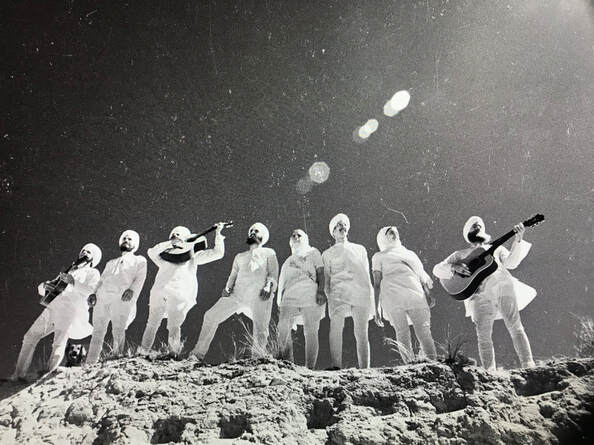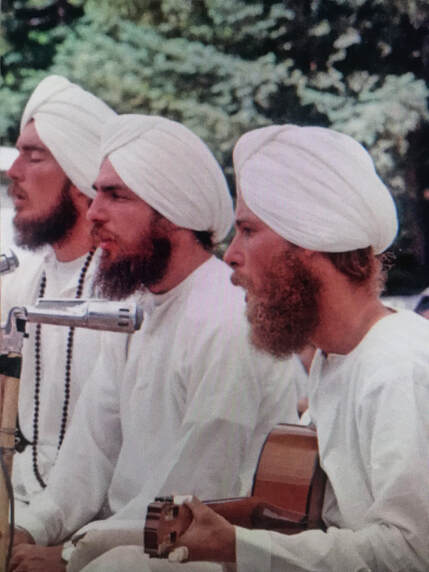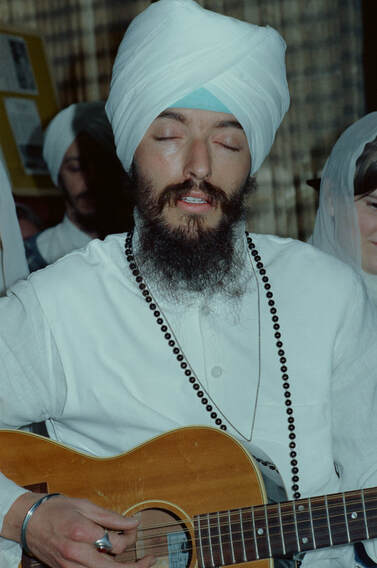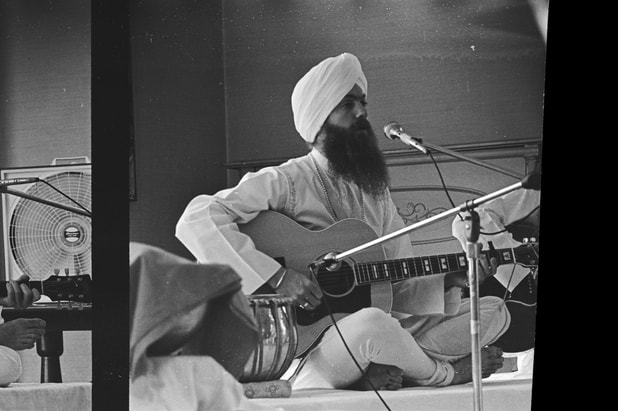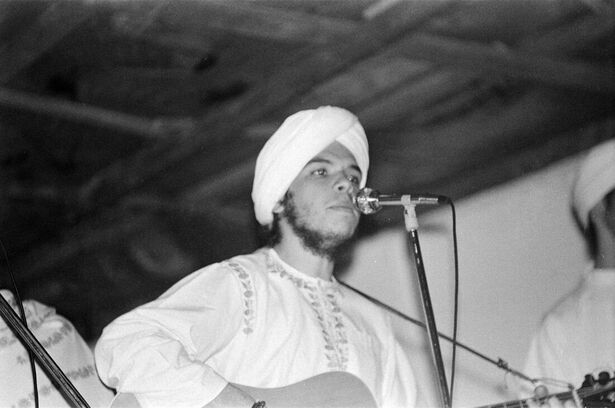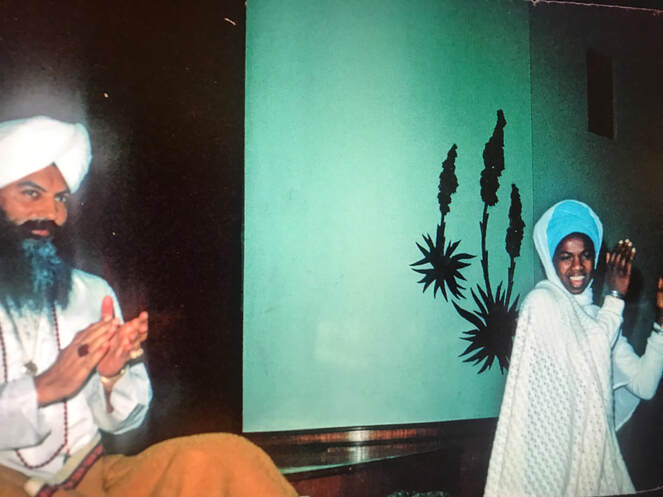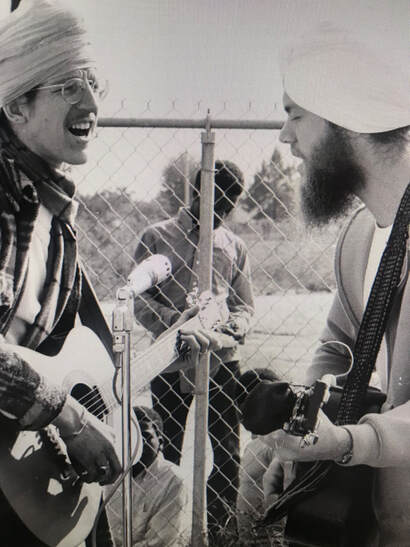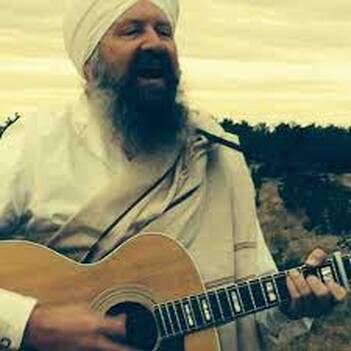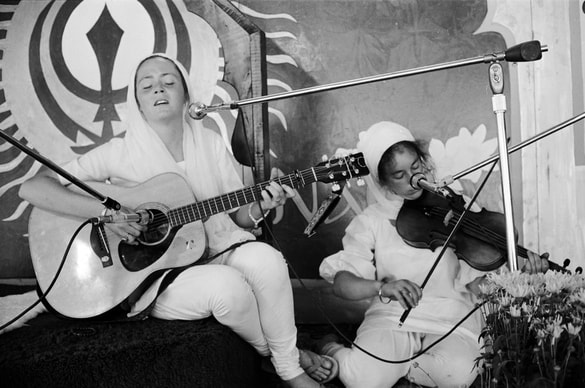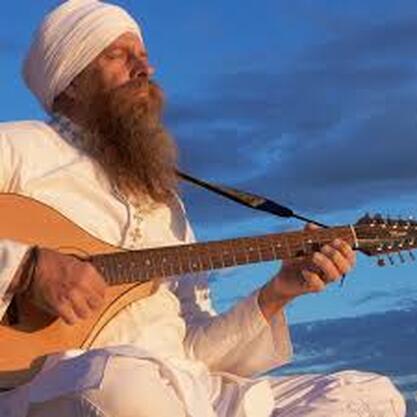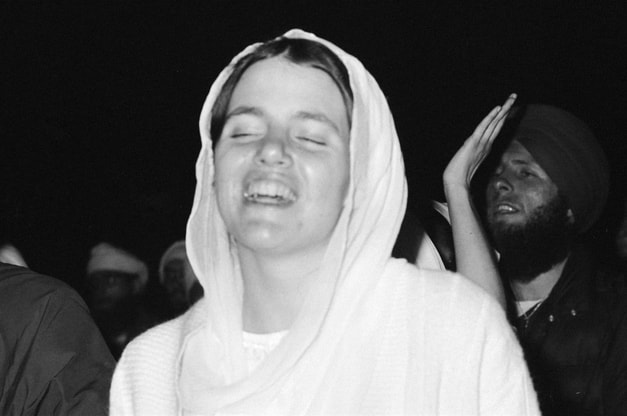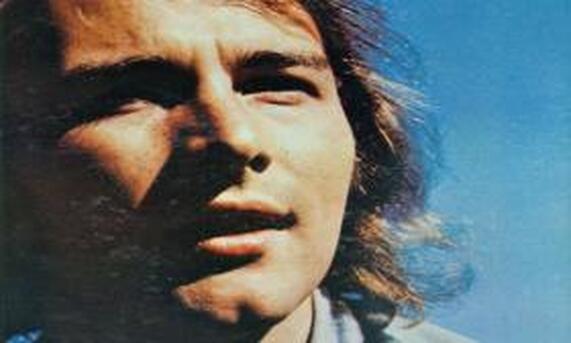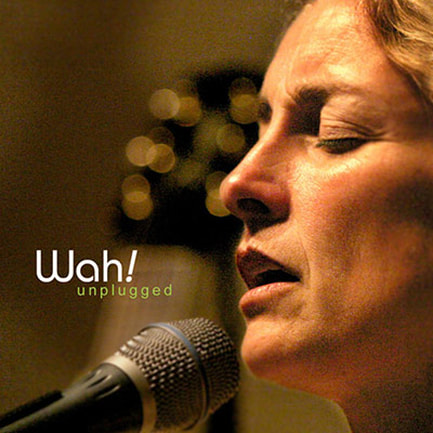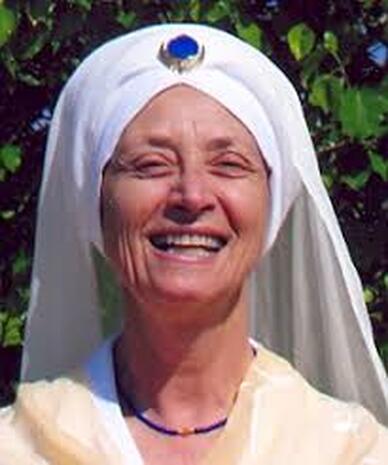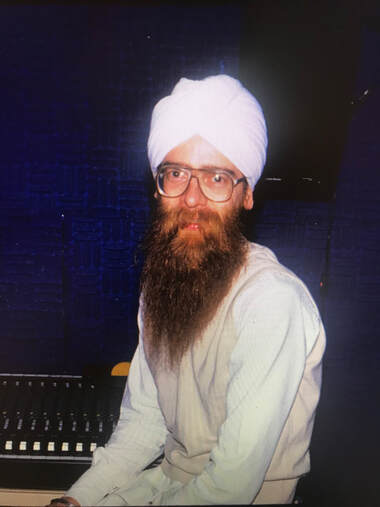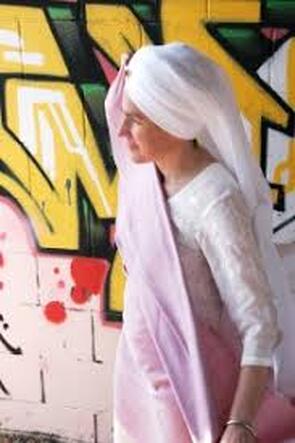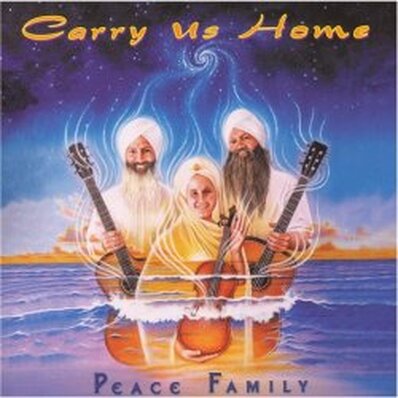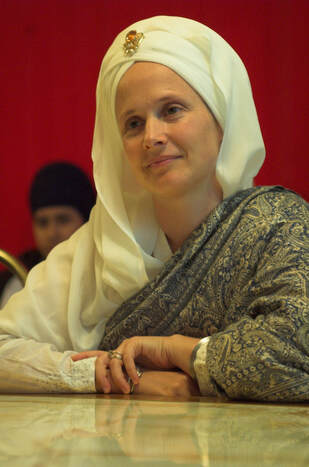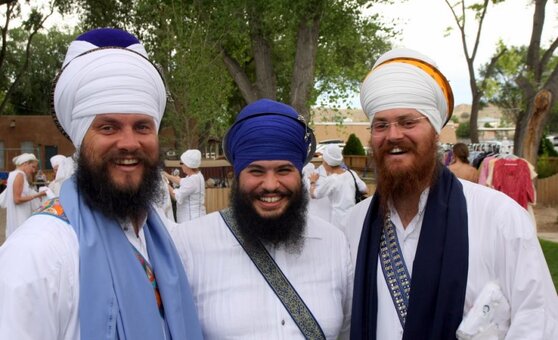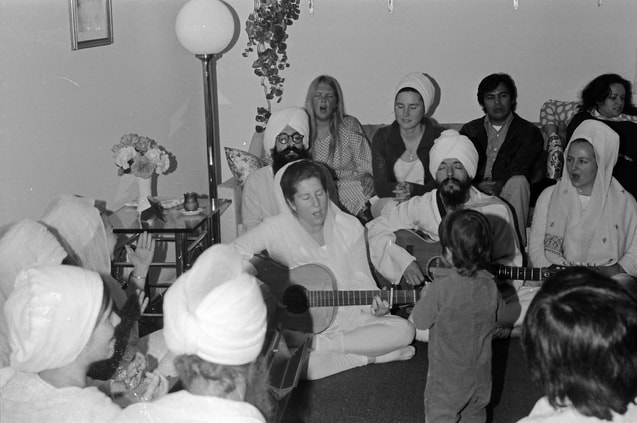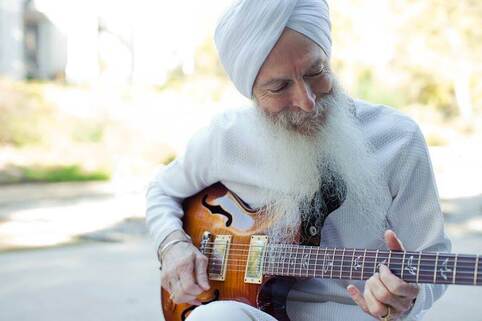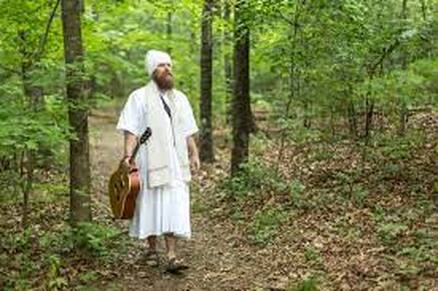Yogi Bhajan Ji
1969 We Are The People of Love
1969 April 13 talk Guru Nanak Man Of Peace
1969 December 25 talk A Spiritual Nation Is Born
Khalsa String Band
1972 JEWELS FROM THE EAST
Captain Karma
Captain Karma
Happiness Runs Through Me
I Love 3HO
Guru Ram Das Rakho Sarnaee
Guru Ram Das
His Kindness
I Had Longed
I Lay Me Down
Ek Ong Kar
Ek Ong Kar (2)
Marching Song
Morning Song
Remember
Long Tall Yogi
1973 THE KHALSA STRING BAND
All For One
America
One Creator
Child's Play LINK
You Can Make The Sun Shine LINK
All For One LINK
Stand For Righteousness LINK
Song of Bliss LINK
Gurutrang Singh
1972 O Guru Ram Das, Thank You For This Beautiful Day!
On an evening in 1972, in the little kitchen of the Panj Pyare Ashram in this big row house with three floors in Baltimore on St Paul Street, there were two shaktis having it out with each other while preparing dinner. I was sitting quietly witnessing the cat fight they were stirring into the stew, at the bottom of the winding steps that lead from the kitchen up to the second floor living quarters. I was thinking they need help. I don’t even think they knew I was there they were so intent upon cooking and arguing. I quietly head up the winding steps to my bedroom, sat on my bed on the floor, picked up my guitar, and began composing “Oh Guru Ram Das, Thank You For This Beautiful Day”. I went back down the stairs, sat with my guitar, and sang this legacy song for the first time. The argument dissipated, and the ashram had a delightful dinner that night, thanks to Guru Ram Das.
1978 The Yogi Tea Song
I penned that one in September 1978 on a piece of scratch paper in the kitchen after a work shift at the Golden Temple Conscious Cookery in Los Angeles while I was going to chiropractic college. The song just kind of came right out. I remember singing it for the first time that year at an impromptu post-Tantric songfest at Winter Solstice at Camp Winona in Deland, Florida. It was immediately following a rigorous day of Tantric with the crowd still seated under the late afternoon sky amongst the evergreens and palms. The Siri Singh Sahib was sitting in the back with his staff. There were several other groups who sang. I was the last to sing as the sun was setting and brought the house down. During the gregarious, resounding applause, the Siri Singh Sahib yelled out from the back, "He's a chronic bachelor. He spends cold nights alone in his sleeping bag. Anyone interested, put your request in at P.O. Box Zero, Zero, Zero, Zero"! Someone did make a request after the crowd turned out, but that's a whole other story!!!
1982 Get Out Of Bed, You Little Sleepy Head!
2002 BEAUTIFUL SADHANA
Wah Yantee LINK
Rakhe Rakhanhar LINK
Mool Mantra LINK
Sat Siri Siri Akal LINK
Guru Ram Das LINK
I sat on my bed on the floor back in 1972, and this song just came out. I remember "manifest" was a funny word to put into a song. I wasn't really sure exactly what it meant but it rhymed and it sounded cool. Originally, the refrain was La La La - La La La - La La La - La La La, not Sat Nam - Sat Nam - Sat Nam - Sat Nam. But that's how songs go. People over time finish them for you. I sing it both ways now. BTW, here's a much better version, the very last song of the very last day, at the name-christening of Sat Nam Fest from Spirit Fest, named after the late Sat Nam Kaur, mother of Hargobind Singh and Sat Darshan Kaur, then married to Satwant Singh, who sponsored yearly sing-alongs at her home, attended by musicians worldwide. Amazingly, Sat Kartar Kaur, singer/musician in the Khalsa String Band, was at that fest somewhere in Maryland or Pennsylvania, and everyone including all the musicians, staff, and audience, nailed it including her, on one take, no rehearsal. We truly manifested the Perfect Name!
2011 (1972) Sat Nam The Grace Within You LINK
Mahendra Kapoor - Nanak Nam Jahaz Hai
About 1973, Yogi Bhajan started the tradition of rousing everybody on the final day of White Tantric Yoga with one more ecstatic feat, one more victorious gesture, and for that he would tell the sound technician to play at full volume the rousing Sikh anthem, Deh Shiva sung by Mahendra Kapoor from the soundtrack of Nanak Naam Jahaaz Hai. After the first time, everyone knew the routine. It was time to join up with anybody close by and energetically run and dance to the martial tune of Deh Shiva as long strings of yogis formed, hand in hand, leaping and snaking their way through the tantric shelter. from Messenger from the Guru's House
1973 (1699, 1969) Deh Shiva
Sat Nam Singh
1975 THERE'LL BE CHANGES
Long Time Sun
Long Time Sun
Send Down The Saints
There'll Be Changes
When You Meet A Lady
Woke Up This Morning
You Can Make The Sun Shine
Guru Singh
1973 Ask For Nothing More
1974 I'll Help You
1976 Sikh Dharma Brotherhood
2001 GAME OF CHANTS (WITH SEAL AND FRIENDS)
Fortunate LINK
I Am LINK
Wahe Guru LINK
Aap Sahaee LINK
Humee Hum LINK
Wha Yantee LINK
Guru Ram Das LINK
Rise Up (1972) LINK
2002 CHANTZ 2 IMPACT EARTH (WITH MIRI PIRI ACADEMY STUDENTS)
Angsang Wahe Guru LINK
Golden Temple Song (1972) LINK
Livtar Singh
1973 Guru Ram Das Medley
The reason I wrote (Song of the Khalsa) was back in 1971, at Summer Solstice, we had the solstice on somebody's farm and the deal was that we could use the farm to have the solstice, as long as we helped the people who lived there with their crops. So every day, for a couple of hours every morning, a whole bunch of people would just go down in the fields and help do weeding and whatever they were doing. And they had this big farm truck with a big flat on the back and instead of sides, it had wooden posts with wooden posts that went across so they made a lattice.
And Yogi ji said he saw the truck full of people being taken down to the farm and he had this image, and he said, "Some day, we'll be taken away in trucks like these to be killed and we'll be singing "May the long time sun shine upon you" as we go to be killed.
And ever since he said that, I always thought, "That's a nice song, but I'd like something with a little more oomph if I'm being taken to be killed." And so that was the genesis of the thought process that brought that kind of... What song would I want to be singing when I am being taken away to be killed? So that's where that came from.
1975 Song of the Khalsa
1982 The Khalsa Way
1983 I am Thine
1984 O My Soul
1986 The Sky of Ram Das Puri
1987 On This Day & Longtime Sun
1987 My Crosswinds
1989 God's Child Is Born
In 1995, in the holy city of Amritsar, a huge and unprecedented Sikh conference took place. It had been organized jointly by the president of the chief religious body, the SGPC, and Yogi Bhajan with the intention of making a statement of strenght and unity after thirteen long years of state terrorism, genocide and repression. There were forces deeply jealous of the Siri Singh Sahib's historic teaching mission outside of Punjab. There were those who wished Sikhs to never be united. There were those who wanted Sikhs to be left behind while the modern world advanced in science, technology and communication. Though the holding of the conference remained in question until the week boefore it was held because of countless security and political considerations.
Finally, Yogi Bhajan arrived with about a hundred students representing a range of nationalities. They brought with them two potent publications, just printed: a scientific overview of the physiology of mantra meditation called "Shabad Guru: Quantum Technology for Awareness" and a full colour book "History of Sikh Dharma of the Western Hemisphere." The book was selectively distributed among leaders and opinion-makers in Amritsar. The overview, in 74 pages, was distributed widely on the Guru Nanak Dev University campus where the conference was held.
On the final day, a large congregation assembled at the historic Manji Sahib Gurdwara on the perimeter of the Golden Temple. There, Yogi Bhajan was feted and celebrated for his work. And there, he and Livtar Singh, introduced the thousands in attendance to the Song of the Khalsa.
Finally, Yogi Bhajan arrived with about a hundred students representing a range of nationalities. They brought with them two potent publications, just printed: a scientific overview of the physiology of mantra meditation called "Shabad Guru: Quantum Technology for Awareness" and a full colour book "History of Sikh Dharma of the Western Hemisphere." The book was selectively distributed among leaders and opinion-makers in Amritsar. The overview, in 74 pages, was distributed widely on the Guru Nanak Dev University campus where the conference was held.
On the final day, a large congregation assembled at the historic Manji Sahib Gurdwara on the perimeter of the Golden Temple. There, Yogi Bhajan was feted and celebrated for his work. And there, he and Livtar Singh, introduced the thousands in attendance to the Song of the Khalsa.
1995 Song Of The Khalsa - recited by Livtar Singh and translated into Punjabi by Yogi Bhajan
1996 I Am A Khalsa Man
1999 Living In The House Of The Fourth Guru
2010 Into the Radiance
2012 I Am
2012 Soul's Ocean
This is the story, the cosmic story, of Wha Wha. Yogi Bhajan was in the car one day with some people. They drove by a pet shop. Yogi ji happened to look in through the petshop window and spotted the puppy, a white Westy (or West Highland Terrier).
He told the driver to STOP! Turn around, go back, and get that puppy. He named the male puppy Wha Wha. (later, a black Scottie would be added to the family as companion for him. She was named Wha Wee.)
Wha Wha became a proud protector of Yogi ji. He took his job very seriously. Not in a mean way, but as a sharp observer of people's demeanor and intent.
Later in his life, he started to have health issues with his lungs. He was sent away from smoggy L.A. to the clear air of Tennessee to live with Rai Kaur (and family), a veterinarian.
No one realized how much he resented being sent away until Yogi ji came to visit one time. Yogi ji sat on a chair. Others gathered around a coffee table. Yogi jj was at one end of the table, everyone else on the sides. Wha Wha was let into the room. Wha Wha went to each person around the table, nuzzled them, took a scratch behind the ear, and said hello. But when he came to Yogi ji, he raised his nose up in the air, and pranced right past him, without even glancing in his direction!
Even with Yogi ji calling to him, "Hey, Wha Wha!", he looked straight and marched past him. Wha Wha then continued around the table, saying hello to each and every other person. Then he sat down without acknowledging Yogi ji in the slightest. It took about 15 minutes before Wha Wha decided to forgive him. He finally came over and "allowed" Yogi ji to pet him. I saw this with my own eyes, or I would not have believed it.
This was a relationship on a level far beyond pet and master. This was equals.
The poem is at once a tribute to his faithful servant, and about seeing the infinite working through the personality and form of Wha Wha. God in the form of Dog. God in the form of any student who becomes master. The aspects of the Wha Wha's character, service, and devotion result in liberation. Ultimate wealth. Doesn't matter which incarnation you are it at the time.
When Wha Wha passed away, Sat Simran, who also loved Wha Wha, happened to be flying across country. She was over Tennessee at the exact moment it happened. She was dozing and had a dream/vision of a great throng of people chanting and raising a great soul into the heavens. She didn't know what it meant, until later after she landed and heard the news. Here is Yogi ji's tribute to perfect devotion.
Gurudass Singh
1974 Flowers In The Rain LINK
1974 Chanting Sat Nam LINK
1975 Song Of Nanak LINK
1976 Ode To Guru Gobind Singh LINK
1979 Siblings of Destiny LINK
1980 Song To My Son LINK
1980 Ram Das Puri LINK
1983 Freedom LINK
1984 All Around The World LINK
1984 Walking Up The Mountain (with Krishna Kaur) LINK
1974 Chanting Sat Nam LINK
1975 Song Of Nanak LINK
1976 Ode To Guru Gobind Singh LINK
1979 Siblings of Destiny LINK
1980 Song To My Son LINK
1980 Ram Das Puri LINK
1983 Freedom LINK
1984 All Around The World LINK
1984 Walking Up The Mountain (with Krishna Kaur) LINK
Krishna Kaur
1975 You Are My Lover, Lord
2004 LONGING
Ong Namo LINK
Namo Namo LINK
Ram Bhajh Pranee Re LINK
Memories LINK
Man Jeetai Jag Jeet LINK
Hari Will Stand By You LINK
Aadays Tisai Aadays LINK
Ong Namo LINK
Namo Namo LINK
Ram Bhajh Pranee Re LINK
Memories LINK
Man Jeetai Jag Jeet LINK
Hari Will Stand By You LINK
Aadays Tisai Aadays LINK
Sat Peter Singh & Livtar Singh
1976 It All Comes Back To You
Guru Shabad Singh
It started with a phone call from his wife. Sarab Shakti Kaur was at a pay phone at the Khalsa women’s camp in New Mexico and she was calling her husband, Guru Shabad Singh at their home in Eugene, Oregon. The year was 1989.
“Hi, Honey,” she said, “the Siri Singh Sahib has taught us this mantra that is the most beautiful I have ever heard. You have to write it down!” It was a command, not a request.
Guru Shabad Singh quickly grabbed a pen and paper from the kitchen drawer and took down the mantra as his wife read it to him, syllable by syllable, as Yogi Bhajan had taught it earlier. She began chanting, “Sa ray sa sa, sa ray sa sa, sa ray sa sa sa rang. Har ray har har, har ray har har, har ray har har har rang.”
“Whoa, that is really cool!” he said, “I’ve never heard one like this before. It’s long!”
In no time, Guru Shabad Singh had picked up his guitar and begun strumming and singing a melody. Soon thereafter, he was in a studio with a producer, determining how it should be recorded. Then, they were doing it. For thirty-one minutes straight, blistered fingers and all, they recorded the song.
The next day, Guru Shabad Singh sent the newly-recorded cassette tape to the Master through his wife, who ran it to his quarters as soon as she received it. When Sarab Shakti Kaur played it for him, he said, “This is perfect!” Without hesitation, Yogi Bhajan continued, “Now, here are two more I want put to music. I need them done quickly. Write this down…” And the work continued.
That afternoon, the Siri Singh Sahib began playing the mantra as it had been recorded, and he continued playing it for the remainder of the camp and beyond. He said, “This is the path of Kundalini music. This tape shall live forever. It brings peace to those on whose forehead peace is not written. It will bring prosperity to those who do not know how to spell it. It will bring you good luck when you have done nothing good, not even in a dream. This is the opening of the lotus which turns the divine Mother back to the navel point.”
Some years later, when Yogi Bhajan was visiting Eugene, he asked that Guru Shabad Singh come to see him. When he arrived, the Master asked, “What is the best-selling mantra in 3HO?”
“Rakhay rakhanhaar?”
“Nope, it’s Sa Ray Sa Sa.”
His student was puzzled. Sa Ray Sa Sa had been available for sale for years and Singh Kaur’s music was trendy at the time.
The Siri Singh Sahib went on to explain that some yoga students from Europe had taken Sa Ray Sa Sa and turned it into a number one hit on the disco charts in Italy. Sure enough, Guru Shabad Singh purchased a copy of the song and they heard it done surprisingly to a Euro beat.
In a private meeting around Summer Solstice in 2002, Yogi Bhajan advised his student that he was going to “die in two years.”
Shortly thereafter, at a yoga class in Espanola, the Master told his recording engineer, Siri Ved Singh, to play another recording Guru Shabad Singh had made, Ajai Alai from Jaap Sahib. As the night went on, he asked Siri Ved to turn the volume up louder… and louder… and louder still, with the Sangat singing at full volume. The thundrous chorus filled the room, the intensity growing by the second.
At one point, it struck Guru Shabad Singh that this might be the last time he would see his teacher. With that thought, came a profound sense of him saying, “Thank you for your music.”
It was all too much for Guru Shabad Singh. Tears began to well up and he felt the need to leave the room. Before doing so, he stole one last look at the Master. When he cleared his eyes enough to see him, he looked at his radiant face and saw that he too was crying. It was a beautiful, musical end to their relationship on the physical plane.
“Hi, Honey,” she said, “the Siri Singh Sahib has taught us this mantra that is the most beautiful I have ever heard. You have to write it down!” It was a command, not a request.
Guru Shabad Singh quickly grabbed a pen and paper from the kitchen drawer and took down the mantra as his wife read it to him, syllable by syllable, as Yogi Bhajan had taught it earlier. She began chanting, “Sa ray sa sa, sa ray sa sa, sa ray sa sa sa rang. Har ray har har, har ray har har, har ray har har har rang.”
“Whoa, that is really cool!” he said, “I’ve never heard one like this before. It’s long!”
In no time, Guru Shabad Singh had picked up his guitar and begun strumming and singing a melody. Soon thereafter, he was in a studio with a producer, determining how it should be recorded. Then, they were doing it. For thirty-one minutes straight, blistered fingers and all, they recorded the song.
The next day, Guru Shabad Singh sent the newly-recorded cassette tape to the Master through his wife, who ran it to his quarters as soon as she received it. When Sarab Shakti Kaur played it for him, he said, “This is perfect!” Without hesitation, Yogi Bhajan continued, “Now, here are two more I want put to music. I need them done quickly. Write this down…” And the work continued.
That afternoon, the Siri Singh Sahib began playing the mantra as it had been recorded, and he continued playing it for the remainder of the camp and beyond. He said, “This is the path of Kundalini music. This tape shall live forever. It brings peace to those on whose forehead peace is not written. It will bring prosperity to those who do not know how to spell it. It will bring you good luck when you have done nothing good, not even in a dream. This is the opening of the lotus which turns the divine Mother back to the navel point.”
Some years later, when Yogi Bhajan was visiting Eugene, he asked that Guru Shabad Singh come to see him. When he arrived, the Master asked, “What is the best-selling mantra in 3HO?”
“Rakhay rakhanhaar?”
“Nope, it’s Sa Ray Sa Sa.”
His student was puzzled. Sa Ray Sa Sa had been available for sale for years and Singh Kaur’s music was trendy at the time.
The Siri Singh Sahib went on to explain that some yoga students from Europe had taken Sa Ray Sa Sa and turned it into a number one hit on the disco charts in Italy. Sure enough, Guru Shabad Singh purchased a copy of the song and they heard it done surprisingly to a Euro beat.
In a private meeting around Summer Solstice in 2002, Yogi Bhajan advised his student that he was going to “die in two years.”
Shortly thereafter, at a yoga class in Espanola, the Master told his recording engineer, Siri Ved Singh, to play another recording Guru Shabad Singh had made, Ajai Alai from Jaap Sahib. As the night went on, he asked Siri Ved to turn the volume up louder… and louder… and louder still, with the Sangat singing at full volume. The thundrous chorus filled the room, the intensity growing by the second.
At one point, it struck Guru Shabad Singh that this might be the last time he would see his teacher. With that thought, came a profound sense of him saying, “Thank you for your music.”
It was all too much for Guru Shabad Singh. Tears began to well up and he felt the need to leave the room. Before doing so, he stole one last look at the Master. When he cleared his eyes enough to see him, he looked at his radiant face and saw that he too was crying. It was a beautiful, musical end to their relationship on the physical plane.
1992 Pavan Pavan LINK
1992 Kal Akal LINK
1999 (1989) Sa Ra Sa Sa LINK
2001 (1699) Ajai Alai LINK
2022 (1699, 1978) Re Man Shabad in Gurmukhi and English LINK
1992 Kal Akal LINK
1999 (1989) Sa Ra Sa Sa LINK
2001 (1699) Ajai Alai LINK
2022 (1699, 1978) Re Man Shabad in Gurmukhi and English LINK
Singh Kaur
1979 PEACE LAGOON
Beloved God
Hukam
Ad Guray Nameh
Recite The Praises
Crimson
I Would Make Myself A Slave
Song Of Bliss
Azure Salver
1983 PEACE LAGOON 2
Peace Lagoon
Joyous Love
Baisakhi
Sopurkh
Gale
Humble Servant
I Had Longed
His Grace
“We were sitting in the St. Louis airport with Yogi Bhajan, who was waiting for a connecting flight to New York City. He asked Singh Kaur to put Rakhe Rakhan Har (a Sikh verse) to music. I was sitting next to her as Yogi Bhajan tapped out the heartbeat rhythm on an empty Styrofoam cup. I wrote the rhythm down, and when we got home, we put the rhythm into Singh Kaur’s drum machine. This is the beat heard on the final recording. The next day I went off to work. When I came home that evening, I asked Singh Kaur about it, and she played a rough recording – basically the finished piece. She had sat down in the morning and the music just flowed through her. I was always amazed and awed by her ability to put the perfect music to any words that came her way – English or Gurmukhi.” - Amar Singh Khalsa
1986 Rakhe Rakhanhar
1986 Wahe Guru Wahe Jio Medley
1986 Remember Him (with Amar Singh Khalsa) LINK
1986 Guru Ram Das (with Kim Robertson) LINK
1988 Mender of Hearts (with Kim Robertson) LINK
1989 Ardas (with Kim Robertson) LINK
1986 Guru Ram Das (with Kim Robertson) LINK
1988 Mender of Hearts (with Kim Robertson) LINK
1989 Ardas (with Kim Robertson) LINK
Mata Mandir Singh Khalsa
As a young man, and student of Kundalini yoga back in the '80s, I had landed in a state of development that is known as "Shakti Pad." It is a state of mind where one's ego starts to question everything one has practiced and learned. In Zen, they say, "Become a lump of doubt!" It is the same thing.
One day, there was a large class, and Yogi Bhajan noticed I was not there and asked where I was.
The students said, "He is working."
He said in what can be described as "Sher bol" or lion speak, "Get him here!"
During a break in the class, I entered and gave my salutations and sat down in front of him.
He said," What is the problem?"
I said, " I don't want to meditate, practice yoga or meditation, and Sir, I don't want to listen to you."
He laughed and said, "None of that matters. Don't you know that all planets, moons, solar systems, and galaxies in the universe are revolving in a perfect rhythm and harmony around each other? All you have to do is pick up any of your instruments and play rhythmic patterns on them, and that will bring you into harmony with all that heavenly glory. That's all you have to do."
I went home and began to follow his advice. It not only worked by getting me through a period of doubt and confusion but became my preferred way of meditation. Through the practice of improvising the rhythmic, melodic patterns, I became quite a prolific composer, releasing nearly thirty plus cassette tapes, CDs, and now downloads into the yoga world in subsequent years.
If I possess a superpower, being a "tunesmith" is it. I am grateful for that advice. It has provided me with countless hours of joy and creativity and the pleasure of singing and playing and recording music with some outstanding musicians on many continents in the beautiful world of yoga. It, of course, also got me through a time of doubt and uncertainty. His advice was to use one's strengths to overcome one's weaknesses.
He then proceeded to tell me to go to India to study tabla, the Indian rhythm system, and Gatka, the martial art of the Sikhs. But that is another story.
One day, there was a large class, and Yogi Bhajan noticed I was not there and asked where I was.
The students said, "He is working."
He said in what can be described as "Sher bol" or lion speak, "Get him here!"
During a break in the class, I entered and gave my salutations and sat down in front of him.
He said," What is the problem?"
I said, " I don't want to meditate, practice yoga or meditation, and Sir, I don't want to listen to you."
He laughed and said, "None of that matters. Don't you know that all planets, moons, solar systems, and galaxies in the universe are revolving in a perfect rhythm and harmony around each other? All you have to do is pick up any of your instruments and play rhythmic patterns on them, and that will bring you into harmony with all that heavenly glory. That's all you have to do."
I went home and began to follow his advice. It not only worked by getting me through a period of doubt and confusion but became my preferred way of meditation. Through the practice of improvising the rhythmic, melodic patterns, I became quite a prolific composer, releasing nearly thirty plus cassette tapes, CDs, and now downloads into the yoga world in subsequent years.
If I possess a superpower, being a "tunesmith" is it. I am grateful for that advice. It has provided me with countless hours of joy and creativity and the pleasure of singing and playing and recording music with some outstanding musicians on many continents in the beautiful world of yoga. It, of course, also got me through a time of doubt and uncertainty. His advice was to use one's strengths to overcome one's weaknesses.
He then proceeded to tell me to go to India to study tabla, the Indian rhythm system, and Gatka, the martial art of the Sikhs. But that is another story.
1981 God Loves Us When We Sing
2012 Guru Ram Das LINK
2012 Let There Be Peace LINK
2012 Mansions Of Pearls LINK
2012 Love Is An Ocean LINK
2012 Hum Dhum LINK
2012 Chanting Saat LINK
2012 Let There Be Peace LINK
2012 Mansions Of Pearls LINK
2012 Love Is An Ocean LINK
2012 Hum Dhum LINK
2012 Chanting Saat LINK
Sat Kartar Kaur Khalsa
1982 Ong Namo / Sat Kartar
1982 I Am I Am
1982 Angsang Waheguru
1982 Guru Ram Das
1982 Aartee / Long Time Sun
2012 Sat Gur Prasaad LINK
2012 Jap Man Sat Nam LINK
2012 Gobinday Mukanday LINK
2012 Laya Mantra LINK
2012 Sa Re Sa Sa LINK
2012 Aad Sach LINK
2012 Jap Man Sat Nam LINK
2012 Gobinday Mukanday LINK
2012 Laya Mantra LINK
2012 Sa Re Sa Sa LINK
2012 Aad Sach LINK
Don Cooper
1983 Bara Maha (Guru Nanak's 12 Months)
1983 Thou Art (with Krishna Kaur)
Waheguru Kaur Khalsa
1984 Bheta
1984 Drink Deep The Nectar
1984 Khalsa Women's Training Camp: Be A Woman
1984 Love And Prayer Of The Soul
1984 Remember God
Sangeet Kaur Khalsa
My story begins in 1976 in the Toronto ashram. I had recently moved in and was familiar with the words of only one shabd, Dhan Dhan Ram Das Gur. I wanted to set it to music, so I brought my guitar upstairs to the Gurdwara, to ‘work’ on it. Now, I don’t actually play guitar. But I knew four chords that I learned from a guitarist friend. I also had never ‘composed’ music, although I was a professional singer at the time. It was one of those magical moments of creation, when the shabd simply ‘downloaded’ – in about 10 minutes. At the time I was quite shy and reticent to sing it in Gurdwara– it seemed so ‘operatic’ compared to the folk-style kirtan that was popular in those days.
Fast forward to 1985. I was married and living in the Millis ashram. Though our marriage was difficult and challenging, I still hoped for a miracle to save it. So I decided to chant the ‘miracle’ shabd, Dhan Dhan Ram Das Gur, 11 times daily, while taking my morning walk. Three days later I received a phone call from a woman unfamiliar to me, Hari Kaur (Katy Houlihan). She was counseling with Guru Charan Singh, who had advised her to get a recording of Dhan Dhan Ram Das Gur. She got an Indian recording and told him she couldn’t relate to it. He said, “Why don’t you get Sangeet to record it?” This extraordinary woman offered to cover all the expenses – from flying in my violinist and flautist, to all the production costs at a fine recording studio, to all the manufacturing costs to duplicate the first 1000 tapes etc. etc. This was indeed a miracle, although not the one I had prayed for!
There was a second miracle, more subtle, but to me it remains the most healing in all my life. I had had a cold the weekend we recorded; when I listened to it for the first time, all I could hear were my flat notes. There was no satisfaction, just my old pattern of extreme self-criticism. Shortly afterwards, Yogiji came to Millis for a Tantric course. I shyly handed him the cassette tape and then went back to my spot in the Tantric line. The next day, when he returned to L.A., I received a phone call that he needed 200 tapes immediately! From then on, he used the recording during classes in L.A. and wherever in the world he traveled. The miracle that I experienced was this: It felt as though Yogiji ‘had gone into the studio and remastered the tape – tweaked all my flat notes.’ That was a miracle of Yogiji’s healing for me, that I could for once let go of my hyper-critical self and surrender to the self-love that exists in the reality of the shabd. And isn’t that exactly what Yogiji did with all of us – tweaking and remastering parts of our broken selves to become whole?
Fast forward to 1985. I was married and living in the Millis ashram. Though our marriage was difficult and challenging, I still hoped for a miracle to save it. So I decided to chant the ‘miracle’ shabd, Dhan Dhan Ram Das Gur, 11 times daily, while taking my morning walk. Three days later I received a phone call from a woman unfamiliar to me, Hari Kaur (Katy Houlihan). She was counseling with Guru Charan Singh, who had advised her to get a recording of Dhan Dhan Ram Das Gur. She got an Indian recording and told him she couldn’t relate to it. He said, “Why don’t you get Sangeet to record it?” This extraordinary woman offered to cover all the expenses – from flying in my violinist and flautist, to all the production costs at a fine recording studio, to all the manufacturing costs to duplicate the first 1000 tapes etc. etc. This was indeed a miracle, although not the one I had prayed for!
There was a second miracle, more subtle, but to me it remains the most healing in all my life. I had had a cold the weekend we recorded; when I listened to it for the first time, all I could hear were my flat notes. There was no satisfaction, just my old pattern of extreme self-criticism. Shortly afterwards, Yogiji came to Millis for a Tantric course. I shyly handed him the cassette tape and then went back to my spot in the Tantric line. The next day, when he returned to L.A., I received a phone call that he needed 200 tapes immediately! From then on, he used the recording during classes in L.A. and wherever in the world he traveled. The miracle that I experienced was this: It felt as though Yogiji ‘had gone into the studio and remastered the tape – tweaked all my flat notes.’ That was a miracle of Yogiji’s healing for me, that I could for once let go of my hyper-critical self and surrender to the self-love that exists in the reality of the shabd. And isn’t that exactly what Yogiji did with all of us – tweaking and remastering parts of our broken selves to become whole?
1985 Dhan Dhan Ram Das Gur (The Blessing)
Liv Singh Khalsa
1987 Adorned With Honour
Avtar Singh Khalsa
1990 Guru Ram Das Blues
Dev Suroop Kaur
1999 Don't Cry For Me Children of Sikh Dharma LINK to Article & Song
2008 ESSENCE
From One Vibration LINK
Ong Namo LINK
Ardas Bhaee LINK
Guru Guru Wahe Guru LINK
Sat Naam LINK
Sat Narayan Wahe Guru LINK
On This Day / Long Time Sun LINK
Peace To All LINK
2008 ESSENCE
From One Vibration LINK
Ong Namo LINK
Ardas Bhaee LINK
Guru Guru Wahe Guru LINK
Sat Naam LINK
Sat Narayan Wahe Guru LINK
On This Day / Long Time Sun LINK
Peace To All LINK
Peace Family - Livtar Singh, Snatam Kaur, Guruganesha Singh
2000 REUNION
Reunion LINK
Invisible Lord LINK
Light Of Peace LINK
Star In My Sky LINK
At The Feet Of The Teacher LINK
2001 CARRY US HOME
Golden Temple LINK
Perfect Harmony LINK
As It Is In Heaven LINK
True Guru LINK
Quiet Hero LINK
Little Song LINK
Sailin' Through The Stars LINK
We Are We LINK
Reunion LINK
Invisible Lord LINK
Light Of Peace LINK
Star In My Sky LINK
At The Feet Of The Teacher LINK
2001 CARRY US HOME
Golden Temple LINK
Perfect Harmony LINK
As It Is In Heaven LINK
True Guru LINK
Quiet Hero LINK
Little Song LINK
Sailin' Through The Stars LINK
We Are We LINK
Snatam Kaur
2002 Aad Guray Nameh LINK
2003 Ong Sohung LINK
2003 Suni-ai LINK
2004 Ong Namo LINK
2004 Long Time Sun LINK
2005 People of Love LINK
2005 Deep Blue Sea LINK
2006 Mool Mantra LINK
2006 Guru Ram Das Rakho Sarnaee LINK
2009 Mother's Blessing LINK
2009 Servant of Peace LINK
2011 I Am Happy LINK
2003 Ong Sohung LINK
2003 Suni-ai LINK
2004 Ong Namo LINK
2004 Long Time Sun LINK
2005 People of Love LINK
2005 Deep Blue Sea LINK
2006 Mool Mantra LINK
2006 Guru Ram Das Rakho Sarnaee LINK
2009 Mother's Blessing LINK
2009 Servant of Peace LINK
2011 I Am Happy LINK
Chardi Kala Jatha
2003 Deh Shiva
2003 Man Too Jot Saroop Hai
2004 Gagan Damama Bajyo
2006 Live At The Golden Temple April 26
2007 Wahe Guru Wahe Jio
2008 Chattr Chakkr Vartee
2008 Guru Ram Das Rakho Sarnaee
2008 Hey Rav Hey Sas
2008 Re Man Eh Bidh Jog Kamao
2009 Dhan Dhan Ram Das Gur
2009 Mool Mantra
2010 Gur Paras Hum Loh
2011 Kaval Nain Madhur Bain
2012 Asa Di Vaar
Sat Kirin Kaur
2006 Namo Namo LINK
2006 Bisara Ga-ee LINK
2007 Ramadasa LINK
2007 Ong Namo LINK
2007 Waheguru Jio LINK
2007 Guru Ram Das LINK
2007 Jo Mangeh LINK
2007 Aap Sahaee Hoaa LINK
2008 Aad Guray Nameh LINK
2008 Chatara Chakara Vartee LINK
2008 Pavan Guru LINK
2008 Long Time Sun LINK
2008 Amrit Peevo LINK
2008 Living Your Truth LINK
2012 Mere Sahiba LINK
2012 Re Man Eh Bidh Jog Kamao LINK
2006 Bisara Ga-ee LINK
2007 Ramadasa LINK
2007 Ong Namo LINK
2007 Waheguru Jio LINK
2007 Guru Ram Das LINK
2007 Jo Mangeh LINK
2007 Aap Sahaee Hoaa LINK
2008 Aad Guray Nameh LINK
2008 Chatara Chakara Vartee LINK
2008 Pavan Guru LINK
2008 Long Time Sun LINK
2008 Amrit Peevo LINK
2008 Living Your Truth LINK
2012 Mere Sahiba LINK
2012 Re Man Eh Bidh Jog Kamao LINK
Guruganesha Singh
2004 GRATEFUL GANESH
Wah Yantee LINK
Mool Mantra LINK
Sat Siri, Siri Akal LINK
Rakhe Rakhanhar LINK
Wahe Guru Wahe Jio LINK
Guru Ram Das LINK
2006 PURE GANESH
Ek Ong Kar LINK
Ma LINK
In The Light Of My Soul LINK
Adi Shakti LINK
Harinam LINK
Guru Ram Das LINK
2008 JOY IS NOW
Peace Has Begun LINK
Hari Om LINK
Joy Is Now LINK
Aad Sach LINK
Sat Narayan LINK
Wah Yantee LINK
Mool Mantra LINK
Sat Siri, Siri Akal LINK
Rakhe Rakhanhar LINK
Wahe Guru Wahe Jio LINK
Guru Ram Das LINK
2006 PURE GANESH
Ek Ong Kar LINK
Ma LINK
In The Light Of My Soul LINK
Adi Shakti LINK
Harinam LINK
Guru Ram Das LINK
2008 JOY IS NOW
Peace Has Begun LINK
Hari Om LINK
Joy Is Now LINK
Aad Sach LINK
Sat Narayan LINK
Mirabai Ceiba
2008 Wahe Guru (With Snatam Kaur and Guru Ganesha Singh)
2008 OCEAN
Ardas Bhaee LINK
Ocean LINK
Sa Re LINK
Ajai Alai LINK
Que El Eterno Sol LINK
2010 A HUNDRED BLESSINGS
A Hundred Blessings LINK
Sa Ta Na Ma LINK
Pavan Guru LINK
Aadays Tisai Aadays LINK
2011 AWAKENED EARTH
Ong Namo LINK
Aad Guray Nameh LINK
Sat Gur Prasad LINK
Guru Ram Das Rakho Sarnaee LINK
Go In Beauty LINK
Ardas Bhaee LINK
Ocean LINK
Sa Re LINK
Ajai Alai LINK
Que El Eterno Sol LINK
2010 A HUNDRED BLESSINGS
A Hundred Blessings LINK
Sa Ta Na Ma LINK
Pavan Guru LINK
Aadays Tisai Aadays LINK
2011 AWAKENED EARTH
Ong Namo LINK
Aad Guray Nameh LINK
Sat Gur Prasad LINK
Guru Ram Das Rakho Sarnaee LINK
Go In Beauty LINK
Gurunam Singh
2008 THE JOURNEY HOME
Ong Namo LINK
Gobinday Mukanday LINK
Pavan Guru LINK
Dukh Parhar LINK
2010 SILENT MOONLIGHT MEDITATION
Dharti Hai LINK
Aad Guray LINK
2012 CHANGE
Waheguruji Ka Khalsa LINK
Har Ji LINK
Ant Na Siftee LINK
Unto Thee LINK

